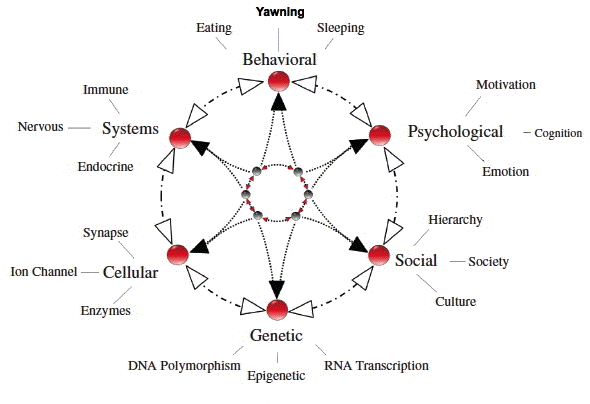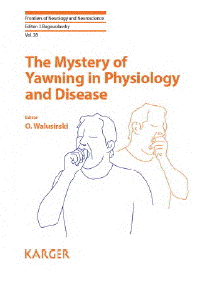- Fetal
Yawning
- in
Sonography Edited by Kerry
Thoirs
- ISBN
978-953-307-947-9, Hard cover, 346 pages
Publisher: InTech
-
- The yawn is a stereotyped and often
repetitive motor act characterized by gaping of
the mouth accompanied by a long inspiration of
breath, a brief acme, and then a short
expiration of breath. Stretching and yawning
simultaneously is known as pandiculation. It is
not merely a simple opening of the mouth but a
complex coordinated movement bringing together a
flexion followed by an extension of the neck, a
wide dilatation of the pharyngolarynx with
strong stretching of the diaphragm and
antigravity muscles.
-
- Ethologists agree that almost all
vertebrates yawn. Yawning is morphologically
similar in reptiles, birds, mammals, and fish.
These behaviors may be ancestral vestiges
maintained throughout evolution, with little
variation (phylogenetic old origins).
Correlatively, yawning can be visualized as
early as 12 weeks during the period of fetal
development.
-
- Systematic and coordinated pandiculations
occur in a similar pattern and form across all
animals, and consistently occur during behaviors
associated with cyclic life rhythms: sleep
arousal, feeding, and reproduction. Yawning
appears as one undirected response to an inner
stimulation, underlying the homeostasis of these
three behaviors.
-
- Species that sleep 8 to 12 hours and
alternate between active and inactive periods
(e.g., predatory carnivores and primates) yawn
much more frequently (following a circadian
rhythm) than herbivores. In humans, daily
frequency of yawning varies between 5 and 15
times per day. The diurnal distribution of
yawning frequency is illustrated by higher
frequency upon waking and before sleep.
-
- Neurophysiology
- A good number of clinical and
pharmacological data indicate that yawning
involves a group of oxytocinergic neurons
originating in the paraventricular nucleus of
the hypothalamus (PVN), and projecting to
extrahypothalamic brain areas (e.g.,
hippocampus, medulla oblongata, and spinal
cord). The PVN is an integration center between
the central and peripheral autonomic nervous
systems. It is involved in a number of functions
ranging from feeding and metabolic balance to
sexual behavior and yawning. Activation of these
neurons by dopamine and its agonists, excitatory
amino acids (N-methyl-D-aspartic acid), oxytocin
itself, or by electrical stimulation leads to
yawning; conversely their inhibition by
gamma-aminobutyric acid and its agonists or by
opioid peptides and opiate-like drugs inhibit
both yawning and sexual response. Other
compounds modulate yawning by activating central
oxytocinergic neurons: sexual hormones,
serotonin, hypocretin, and endogenous peptides
(adrenocorticotropin-melanocytestimulating
hormone). Oxytocin activates cholinergic
neurotransmission in the hippocampus and the
reticular formation of the brainstem.
Acetylcholine induces yawning via the muscarinic
receptors of effectors from which the
respiratory neurons in the medulla; the motor
nuclei of the 5th,7th, 9th, 10th, and 12th
cranial nerves; the phrenic nerves (C1-C4); and
the motor supply to the intercostal
muscles.
-
- Contagiousness of Yawning
- It seems that hominids have the unique
capacity to be receptive to the contagiousness
of yawning. In humans, echokinesis only occurs
in situations of minimal mental stimulation
(public transport, waiting); people are not
susceptible to this phenomenon during prolonged
intellectual effort.
-
- Yawning appears to trigger a sort of social
coordination function and reflects the capacity
to unconsciously and automatically be influenced
by the behavior of others. Autistic individuals
who are characterized by impaired mental state
attribution do not show contagious yawning. All
these data support the hypothesis that
contagious yawning shares the neural networks
implicated in self-recognition and mental state
attribution; it may therefore be that yawning is
involved in empathy.
-
- Yawning in diseases
- Excessive yawning is a source of
embarrassment in social circles. There are
multiple causes of excessive yawning, that is, a
cluster of 10 to 50 yawns, many times a day. Of
short duration, they may predict a vasovagal
reaction or neurovegetative disorders
(dyspepsia, migraine-like syndromes). All
insults to the intracranial central nervous
system or the hypothalamo-hypophyseal region may
be involved: tumors with intracranial
hypertension, infections, temporal epilepsy,
strokes, etc. Actually, iatrogenic pathology
(serotoninergic agents, apomorphine,
acetylcholinesterase inhibitors, opiate
withdrawal) is the most frequent explanation of
pathologic cases. Excessive yawning may also
predict a sleep apnea syndrome with
sleepiness.
-
- Why do we yawn ? The hypothesis
- Yawning does not accelerate blood flow. This
blood-flow theory argued that yawning improved
the oxygenation of the brain, in response to
cerebral anemia. The inaccuracy of this
hypothesis was formally invalidated by Provine,
Tate, and Geldmacher (1987). In his studies, he
has demonstrated that breathing neither pure O2
nor gases high in CO2 had any significant effect
on yawning, although both increased breathing
rate. In a second study, he has found that
exercise sufficient to double breathing rate had
no effect on yawning. Although the available
data are far from providing a complete and
generally accepted account of the physiological
function of yawning, progress has been made in
ruling out previously held hypotheses.
-
- Conclusion
- Yawning and pandiculation are transitional
behaviors, universal among vertebrates, closer
to an emotional stereotypy than a reflex.
Phylogenetically ancient and ontogenetically
primitive, they may provide some evolutionary
advantage. They seem to exteriorize homeostatic
processes of systems controlling wakefulness,
satiety, and sexuality in the diencephalon.
-
 - References
-
- Barbizet,
J. (1958). Yawning. Journal of Neurology,
Neurosurgery, and Psychiatry, 21(3),
203-209.
-
- Collins,
G. T., & Eguibar, J. R. (2010).
Neurophamacology of yawning. Frontiers of
Neurology and Neuroscience, 28, 90-106.
-
- Deputte, B.
L. (1974). Revue sur le comportement de
bâillement chez les
vertébrés. Bulletin interne
Société Française pour
l'étude du comportement animal, 1,
26-35.
-
- Guggisberg,
A. G., Mathis, J., Schnider, A., & Hess, C.
W. (2010). Why do we yawn? Neuroscience and
Biobehavioral Reviews, 34, 1267-1276.
-
- Nahab, F.
B. (2010). Exploring yawning with
neuroimaging. Frontiers of Neurology and
Neuroscience, 28, 128-133.
-
- Platek,
S. M., Mohamed, F. B., & Gallup, G. G.,
Jr. (2005). Contagious yawning and the
brain. Cognitive Brain Research, 23,
448-452.
-
- Provine, R.
R., Tate, B. C., & Geldmacher, L. L.
(1987). Yawning: No effect of 3-5% CO2, 100% O2,
and exercise. Behavioral and Neural Biology,
48(3), 382-393. 811
|



